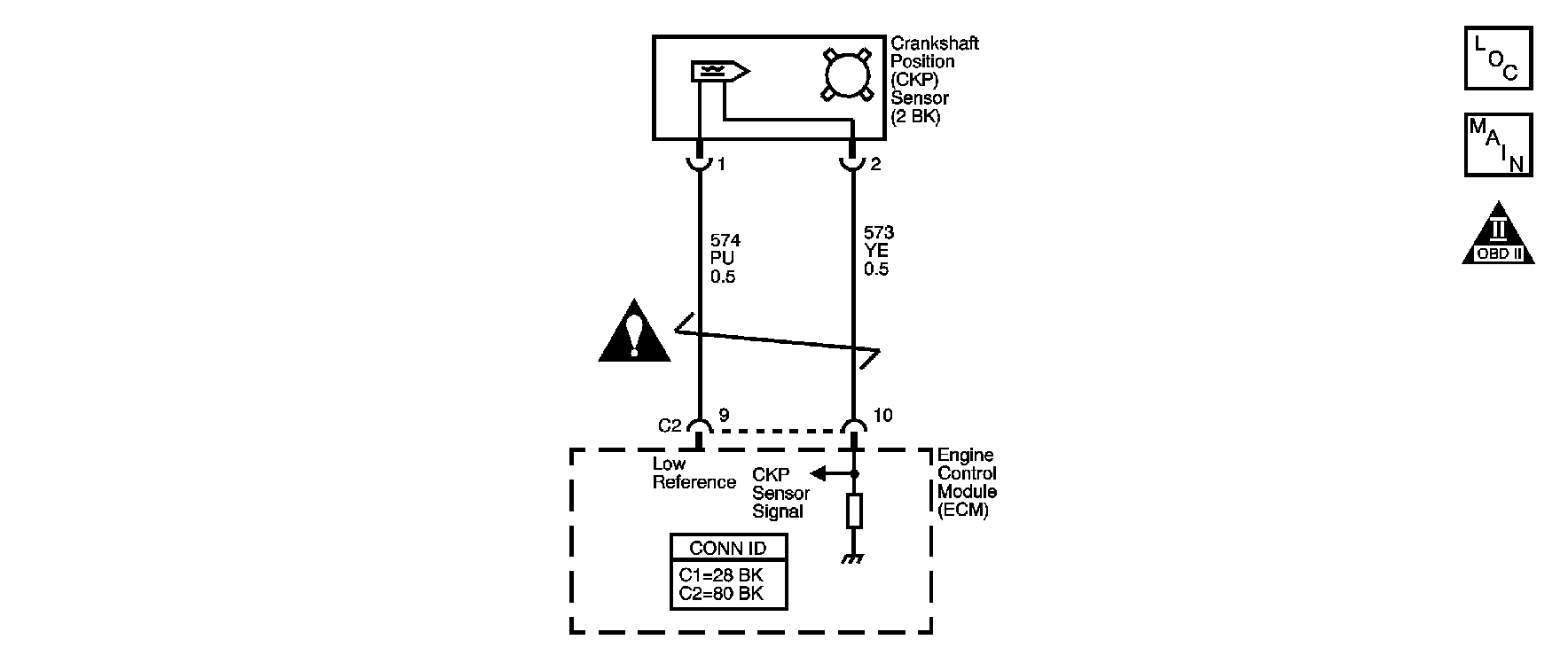
Circuit Description
The crankshaft position (CKP) sensor indicates the crankshaft speed and position. The CKP sensor produces an AC voltage of different amplitude and frequency. The frequency depends on the velocity of the crankshaft. The AC voltage output depends on the crankshaft position and the battery voltage. The CKP sensor works in conjunction with a 7X reluctor wheel attached to the crankshaft. The CKP sensor connects to the engine control module (ECM) through the following circuits:
| • | The CKP sensor signal |
| • | The low reference |
If the ECM detects an incorrect number of pulses from the CKP sensor, DTC P0336 sets.
Conditions for Running the DTC
The engine is running.
Conditions for Setting the DTC
The ECM detects extra or missing crankshaft sensor pulses.
Action Taken When the DTC Sets
| • | The control module illuminates the malfunction indicator lamp (MIL) on the second consecutive ignition cycle that the diagnostic runs and fails. |
| • | The control module records the operating conditions at the time the diagnostic fails. The first time the diagnostic fails, the control module stores this information in the Failure Records. If the diagnostic reports a failure on the second consecutive ignition cycle, the control module records the operating conditions at the time of the failure. The control module writes the operating conditions to the Freeze Frame and updates the Failure Records. |
Conditions for Clearing the MIL/DTC
| • | The control module turns OFF the malfunction indicator lamp (MIL) after 3 consecutive ignition cycles that the diagnostic runs and does not fail. |
| • | A current DTC, Last Test Failed, clears when the diagnostic runs and passes. |
| • | A history DTC clears after 40 consecutive warm-up cycles, if no failures are reported by this or any other emission related diagnostic. |
| • | Clear the MIL and the DTC with a scan tool. |
Step | Action | Values | Yes | No | ||||||||||||||
|---|---|---|---|---|---|---|---|---|---|---|---|---|---|---|---|---|---|---|
Schematic Reference: Engine Controls Schematics Connector End View Reference: Engine Controls Connector End Views or Engine Control Module Connector End Views | ||||||||||||||||||
1 | Did you perform the Diagnostic System Check-Engine Controls? | -- | Go to Step 2 | |||||||||||||||
2 | Attempt to start the engine. Does the engine start and run? | -- | Go to Step 3 | Go to Step 4 | ||||||||||||||
3 |
Did the DTC fail this ignition cycle? | -- | Go to Step 4 | Go to Intermittent Conditions | ||||||||||||||
4 | Test the CKP sensor signal circuit of the CKP sensor for an intermittent condition. Refer to Testing for Intermittent Conditions and Poor Connections and Testing for Electrical Intermittents in Wiring Systems. Did you find and correct the condition? | -- | Go to Step 11 | Go to Step 5 | ||||||||||||||
5 | Test the low reference circuit of the CKP sensor for an intermittent condition. Refer to Testing for Intermittent Conditions and Poor Connections and Testing for Electrical Intermittents in Wiring Systems. Did you find and correct the condition? | -- | Go to Step 11 | Go to Step 6 | ||||||||||||||
6 | Test for an intermittent and poor connection at the ECM. Refer to Testing for Intermittent Conditions and Poor Connections and Testing for Electrical Intermittents in Wiring Systems. Did you find and correct the condition? | -- | Go to Step 11 | Go to Step 7 | ||||||||||||||
7 | Test for an intermittent and poor connection at the CKP sensor. Refer to Testing for Intermittent Conditions and Poor Connections and Testing for Electrical Intermittents in Wiring Systems. Did you find and correct the condition? | -- | Go to Step 11 | Go to Step 8 | ||||||||||||||
8 |
Did you find and correct the condition? | -- | Go to Step 11 | Go to Step 9 | ||||||||||||||
9 | Visually inspect the CKP reluctor wheel for looseness or damage. Refer to Crankshaft and Bearing Cleaning and Inspection in Engine Mechanical. Did you find and correct the condition? | -- | Go to Step 11 | Go to Step 10 | ||||||||||||||
10 | Replace the CKP sensor. Refer to Crankshaft Position Sensor Replacement . Did you complete the replacement? | -- | Go to Step 11 | -- | ||||||||||||||
11 |
Did the DTC fail this ignition? | -- | Go to Step 2 | Go to Step 12 | ||||||||||||||
12 | Observe the Capture Info with a scan tool. Are there any DTCs that have not been diagnosed? | -- | System OK | |||||||||||||||
